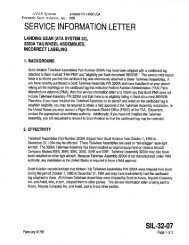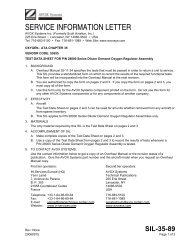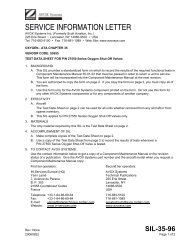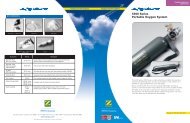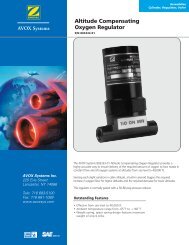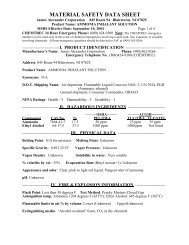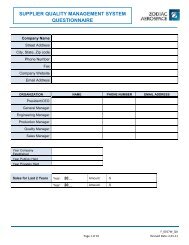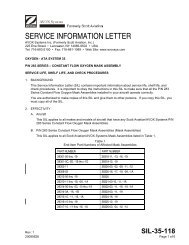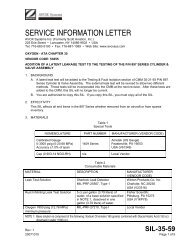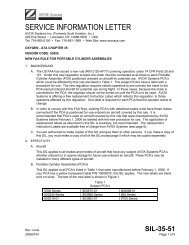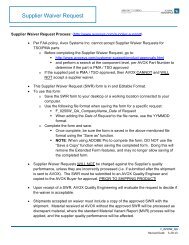Neo-Novacite MSDS - AVOX Systems, Inc.
Neo-Novacite MSDS - AVOX Systems, Inc.
Neo-Novacite MSDS - AVOX Systems, Inc.
You also want an ePaper? Increase the reach of your titles
YUMPU automatically turns print PDFs into web optimized ePapers that Google loves.
NOTICE:The following information has been provided to <strong>AVOX</strong> <strong>Systems</strong> <strong>Inc</strong>. by the supplier ofthe material identified on the document. The information contained in the document is,to the best of our knowledge and belief, accurate. However, <strong>AVOX</strong> <strong>Systems</strong> <strong>Inc</strong>. makesno interpretations and bears no liability with regard to the completeness or accuracy ofsuch information. Any questions regarding the following information or the material towhich it pertains must be directed to the company or organization identified at the top of,Section I of, the document.
MALVERN MINERALS COMATERIAL SAFETY DATA SHEETDate Prepared Jan 2, 2004NOVACITE®SECTION I- CHEMICAL PRODUCT AND COMPANY IDENTIFICATIONCHEMICAL NAME AND SYN.Silicon Dioxide, Silica, Micro Crystalline Silica, Tripoli, Free SilicaAll Grades of NOVACITE®Manufacture’s Name: Emergency Telephone Number 501-623-8893Malvern Minerals Co. (fax) 501-623-5113P.O. Box 1238 (correspondence) Malvern Minerals Co.Hot Springs, AR 71902220 Runyon St. (deliveries)Hot Springs, ARE-Mail: charles.steuart@malvernminerals.comSECTION II- COMPOSITION/INFORMATION ON INGREDIENTSIngredients: Chemical Typical %Formula by Weight CAS #Crystalline Silica (quartz) SiO2 99.12 % 14808-60-7Aluminum Oxide Al2O3 0.04 % 1344-28-1Titanium Oxide TiO2 0.015 % 13463-67-6-7Iron Oxide Fe2O3 0.04 % 1309-37-1Exposure Limits for Hazardous IngredientsOSHA PEL ACGIH TLV NIOSH RELCrystalline Silica (quartz) 10 mg/m³ .05 .05(respirable) % SiO2 + 2Exposure limits are time weighted average concentrations for 8-hr up to a 10-hr shift, 40hours per week.OSHA – Occupational Safety and Health AdministrationMSHA – Mine Safety and Health AdministrationACGIH – American Conference of Governmental Industrial HygenistsPEL - Permissible Exposure LimitTLV - Threshold Limit ValueTWA - Time Weighted Average, 8 hoursSECTION III – HAZARDS IDENTIFICATIONEMERGENCY OVERVIEWMalvern Minerals Co. silica is white to light gray in color and is in a powder form. It is notknown to be environmentally hazardous. The silica is chemically inert and is a noncombustiblemineral. Excessive and long-term exposure to silica dust may cause lungdisease or silicosis.
When crystalline silica is heated to more than 870ºC it forms trydimite. Crystalline silicaheated over 1470ºC the can change to cristobalite. The OSHA PEL for crystalline silica astrydimite and cristobalite is one-half of the OSHA PEL for crystalline silica (quartz).HEALTH HAZARDSPotential Health Effects Through Inhalation1. Silicosis Respirable crystalline silica can cause a scarring of the lungs(fibrosis) known as silicosis. Symptoms include cough, shortnessof breath, wheezing and reduced pulmonary function. The diseasemay be aggravated by smoking. Silicosis may be progressive andmay lead to disability and death.2. Cancer Crystalline silica (quartz), inhaled from occupational sources, isconsidered a carcinogenic to humans. Refer to IARC Monograph68, Silica, Some Silicates and Organic Fibers (published in June’97)3. Nephrotoxicity There are some studies that show an increased occurrenceof chronic kidney disease and end-stage renal disease in workers exposedto excessive respirable crystalline silica.4. Autoimmune Diseases There are several studies an increased frequency ofcontracting scleroderma and other connective tissue disorders in workersexposed to respirable crystalline silica.5. Tuberculosis Silicosis increases the risk of tuberculosis.OTHERSkin Contact No adverse effectsEye Contact Crystalline silica may cause irritation and possible abrasion to theCornea.Ingestion Not applicable.Chronic Effects Silicosis, cancer, autoimmune diseases, tuberculosis. and nephrotoxicityare all chronic effects.Signs and Symptoms of Exposure There are generally no signs or symptoms ofexposure to crystalline or silica.SECTION IV – FIRST AID MEASURESGross Inhalation Remove victim to fresh air, give artificial respiration as needed, seekmedical attention as needed.Eye Contact Flush eyes immediately with water. If irritation continues, seekmedical attention.Skin Contact Wash exposed skin with soap and water.Ingestion N/AMedical Conditions Aggravated by Exposure: Conditions of individuals with lungdisease can be aggravated by exposure to respirable silica (quartz).
SECTION V – FIRE FIGHTING MEASURESCrystalline silica, in the form of quartz, is not flammable, combustible or explosive.SECTION VI – ACCIDENTAL RELEASE MEASURESSpills Use dustless methods (HEPA vacuum or wet method). Do not sweep. Wearprotective equipment specified in Section XIII.SECTION VII – HANDLING AND STORAGEPrecautionary Measures Do not breath dust. Use adequate ventilation and properdust collection. Maintain and use proper, clean respiratory equipment. SeeSec. VIII for proper respiratory equipment. Be careful with bags orcontainers to prevent spills or damage to bags. Do not use as a dry abrasiveblasting agent. Use good housekeeping in storage areas and keep dust off offloor, bags and rafters. Employees that are handling micro silica (quartz)need to be trained in accordance with State and Federal regulations.IN CASE OF RESALE, BAGS AND CONTAINERS MUST HAVE APPROPRIATE WARNINGLABLES ATTACHED AND POSTED AS TO MSHA AND OSHA PRECAUTIONS ANDREGULATIONS. PROVIDE PROPER TRAINING FOR YOUR EMPLOYEES.Additional information on silica hazards and precautions can be found:NIOSH Joint campaign on Silicosis Prevention http://www.cdc.gov/niosh/sicampn.htmlOSHA Crystalline Silica Website http://www.osha-slc.gov/SLTC/silicacrystalline/index.htmlMSHA Silicosis Prevention Website http://www.msha.gov/S&HINFO/SILICO.HTMSECTION VIII – EXPOSURE CONTROL/PERSONAL PROTECTIONVentilation Use sufficient exhaust to maintain exposures below occupationalexposure limits (PEL). See ACGIH “ Industrial Ventilation. A Manual ofRecommended Practice”Respiratory Protection Use appropriate respiratory protection as covered inThe most recent standards of ANSI (Z88.2), OSHA (29 CFR 1910.134, MSHA(30 CFR Parts 56 and 57) and NIOSH Respirator Decision Logic.Gloves RecommendedEye Protection Safety glasses or goggles are recommendedSECTION IX – PHYSICAL AND CHEMICAL PROPERTIESAppearance White or light gray powderEvaporation Rate N/AOdor None Specific Gravity 2.65
Vapor Pressure (mm Hg.) 10mm@1732ºC Melting Point 1710ºCVapor Density N/AEvaporation Rate N/ASolubility in waterInsolubleSECTION X – STABILITY AND REACTIVITYStability Crystalline silica (quartz) is stable.<strong>Inc</strong>ompatibility Don’t contact with oxidizing agents such as fluorine, manganesetrioxide and chlorine trifluoride.Hazardous Decomposition or Byproducts Silica will dissolve in hydrofluoric acidProducing a corrosive gas, silicon tetrafluoride.Hazardous Polymerization Will not occur.SECTION XI – TOXICOLOGICAL INFORMATIONRefer to SECTION III – HAZARD IDENTIFICATION.No Ecotoxic data is available.SECTION XII – ECOLOGICAL INFORMATIONSECTION XIII - DISPOSALDispose of waste by any approved solid waste disposal method- Limit exposure sothat it does not exceed OSHA standard TLV. Wet to limit dust.SECTION XIV – TRANSPORTATION INFORMATIONU.S. DOT HAZARD CLASSIFICATION For purposes of transportation underthe U.S. Department of Transportation Table of Hazardous Materials, 49 CFR §172 .101, crystalline silica (quartz) is not considered a hazardous material.SECTION XV – REGULATORY INFORMATIONTSCA Toxic Substances Control Act: All of the components of the silica are on theinventory or exempt from the notification requirements.SARA 311/312 Hazard Categories for SARA Sec. 311/312 Reporting: ChronicHealth.
SARA 313 This Product Contains the Following Chemicals Subject to AnnualRelese Reporting Requirements Under the SARA Sec. 313 (40CFR 372):NONECERCLA Section 103 Reportable Quantity: NONECanadian Environmental Protection Act: Naturally occurring silica (quartz) islisted on the Domestic Substances List and is exempt.European Inventory of Commercial Chemical Substances: Exempt from notificationRequirements. EINECS number for Quartz is 231-545-4California Proposition 65: Crystalline silica (quartz) is classified as a carcinogen.Australian Inventory of Chemical Substances: Exempt from notificationrequirements.Japan MITI: All components are defined in the Chemical Substance Control Law.WHMIS Classification: D2AIARC: Crystalline silica (quartz) is classified in IARC Group 1SECTION XVI – OTHER INFORMATIONHazardous Material Information System: HMISHealth * Flammability 0 Reactivity 0 Protective Equipment E* See section III of this <strong>MSDS</strong>.National Fire Protection Association NFPA:Health 0 Flammability 0 Reactivity 0NOTE: While the information and recommendations set forth herein are believedto be accurate as of the date thereof, THE MANUFACTURER MAKESNO WARRANTY WITH RESPECT THERETO AND DISCLAIMERSALL LIABILITY FROM RELIANCE THEREON.The data in this <strong>MSDS</strong> relates only to the specific material designated herein and does not relate touse in combination with and other material or process. Nothing herein is to be taken as a license tooperate under or a recommendation to infringe on patents or registered trademarks. Any use ofthese data and information must be determined by the user to be in accordance with federal, stateand local laws and regulations.Prepared by: Charles T. Steuart



